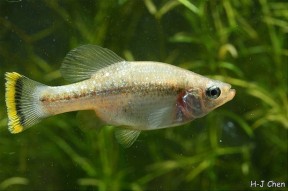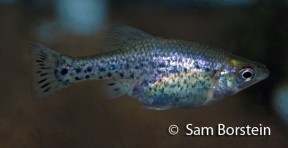Ameca splendens
Butterfly Goodeid, Butterfly Splitfin, Ameca-Hochlandkärpfling (DE)
SynonymsTop ↑
Ameca splendens Gärtner, 1981
Etymology
Ameca: named for the upper Ameca River basin in the state of Jalisco, westerm México, an area to which the genus was formerly considered endemic.
splendens: Latin term for ‘bright, glittering, shining’, in reference to this species’ “striking” colour pattern.
Classification
Order: Cyprinodontiformes Family: Goodeidae
Distribution
Was for many years considered endemic to the Río Ameca drainage basin in Jalisco state, central-western Mexico including its tributary the Río Teuchitlán, but now known to occur in the neighbouring valley of Sayula, where several populations have been discovered. Incorrectly listed as extinct by the IUCN at time of writing.
Habitat
Clear springs where aquatic plants proliferate.
Maximum Standard Length
80 – 90 mm.
Aquarium SizeTop ↑
Base dimensions of at least 90 cm x 30 cm are a prerequisite.
Maintenance
A densely planted aquarium with a dark substrate will allow it to exhibit its colours to the best effect. Well-oxygenated water with a moderate water flow is also needed. Efficient filtration is essential as, not only is this a messy species, but it’s also sensitive to deteriorating water quality.
Water Conditions
Temperature: 24 – 24 °C
pH: 7.0 – 8.0
Hardness: 179 – 357 ppm
Diet
An omnivorous and greedy feeder, it will accept most foods offered. It does consume large amounts of algae in the natural habitat so some greenstuffs should be included in the diet. Blanched spinach, nori (dried seaweed) and Spirulina flake all work well.
Behaviour and CompatibilityTop ↑
Not a good community fish as it can be quite aggressive, particularly the males. It’s also very competitive at feeding time. It can be maintained in a community of similarly sized, robust species but is better kept in a species setup.
Sexual Dimorphism
Males are smaller and more colourful than females, possessing reflective scales all along the flanks and a black and yellow edge to the caudal fin. They also possess an andropodium (a notched anal fin used for reproduction, similar to the gonopodium in other livebearers). Mature males sometimes develop very broad backs.
Reproduction
An easily-bred live bearer. A species tank works best, and it can be bred using a single pair or a group (this is known as flock spawning). The breeding tank should be planted very heavily. Goodeids breed in a slightly different way to other livebearers, as females don’t store sperm as in many other livebearing species, and must be fertilised separately for each brood of young. They also display no gravid spot.
The female initiates mating by swimming diagonally in front of the male and performing quivering movements. This increases in intensity and the male exhibits his strongest colouration before joining in the courtship. Eventually the fish come together and mating occurs.
Gestation takes between 55-60 days after which 5-30 huge (up to 0.75″!) fry are produced. Sometimes these may have what appears to be an umbilical cord attached. This is quite normal (see below) and will disappear in 2-3 days. The fry are large enough to accept the same foods as the adults from birth and will be bold and outgoing from the outset, competing for food with any other fish in the aquarium. The parents rarely predate on the fry.
NotesTop ↑
Despite often being referred to as extinct in the wild this monotypic species is still surviving at a few localities. It’s not particularly scarce in the hobby with strong captive populations existing, some of which have been selectively bred to produce variations in colour and patterning.
As with other goodeids, there is less of a size difference between the sexes than in many other livebearers. This is thought to be related to the relatively primitive structure of the andropodium, as the fish tend to choose mates that are of similar size so that the sex organs are synchronised.
Goodeids are unique among livebearers in that the developing young are nourished by a specialised structure known as the trophotaenia. This performs a similar function to the placenta in mammals and the remnants of it can often be seen attached to the young fish at birth. Male fish also possess an internal muscular structure known as a pseudophallus, which connects the sperm ducts to the genital opening. This is thought to forcibly eject sperm.
In the aquarium, male fish develop a pecking order amongst themselves which involves a great deal of displaying and some nippng, but lasting physical damage is rare. The alpha male in any given group can be identified by his brighter colouration and more vigorous nature.





October 5th, 2019 at 11:32 pm
Is the temperature range really supposed to read 24-24˚C or is that a typo? If it helps, fishbase.de lists their natural temperature range as 26°C-32°C (with scientific reference).